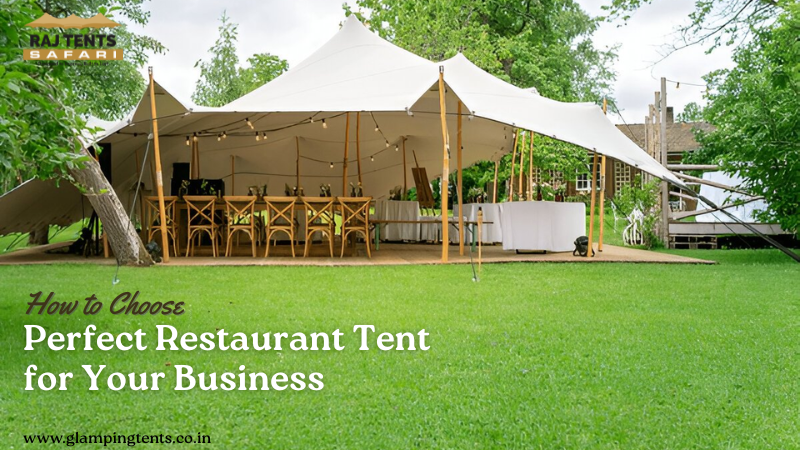How to Choose the Perfect Restaurant Tent for Your Business

In today’s competitive hospitality industry, flexibility and ambience can be just as important as the food you serve. One increasingly popular way for restaurants to expand their seating, offer seasonal experiences, or host private events is by investing in a restaurant tent.
Whether it’s a chic outdoor dining setup, a cozy winter patio, or a large event tent, the right structure can elevate your business and boost revenue.
But with so many options available, how do you choose the perfect restaurant tent? Here’s what to consider before making your investment.
1. Define the Purpose of Your Tent
The first step in choosing restaurant tents is understanding how you intend to use it. Are you adding extra seating for a summer crowd? Hosting weddings or private parties? Creating a permanent outdoor dining space? Your tent’s purpose will influence everything from size and design to material and budget.
Common use cases include:
- Seasonal patio dining
- Weatherproof seating for year-round service
- Pop-up events or food festivals
- VIP/private dining experiences
Knowing your goals will help narrow down the style, features, and build quality you need.
2. Choose the Right Size and Layout
The size of your restaurant tent depends on your available space and the number of guests you want to accommodate. A small sidewalk café might only need a 10’x20’ canopy, while a large venue may require a 40’x60’ frame tent with room for tables, a bar, and entertainment.
Consider not only the footprint, but also the ceiling height. Higher ceilings allow for better air circulation and a more open, upscale feel especially for events or formal dining.
Make sure to account for:
- Table spacing (ADA compliance if necessary)
- Aisle space for staff and guests
- Space for heaters, fans, or décor
- Tent anchoring and perimeter clearance
3. Consider the Climate and Weather Resistance
Outdoor dining is only enjoyable when your customers are comfortable. Choose a tent designed to handle the climate in your region. For example:
- In windy or rainy areas, opt for tents with strong anchoring systems, sealed seams, and durable waterproof fabrics.
- In hot climates, look for UV-resistant materials, open ventilation options, or roll-up walls for airflow.
- For colder seasons, select tents that can accommodate heating units or offer insulation.
Frame tents, clearspan structures, and high-peak tents tend to perform well in year-round environments, offering strength and versatility.
4. Material Quality and Durability
Your tent’s materials should be suited to your business’s volume and weather exposure. Look for:
- Heavy-duty vinyl or PVC for the canopy—these are waterproof, fire-retardant, and resistant to mildew or UV damage.
- Powder-coated steel or aluminum for frames—these materials provide long-lasting support with minimal maintenance.
- Reinforced seams, durable zippers, and strong connectors are also essential for longevity.
If you’re investing in a semi-permanent structure, durability should be a top priority to avoid frequent repairs or replacements.
5. Style and Aesthetics
A restaurant tent is more than a shelter—it’s an extension of your brand. Whether you run a rustic brewery, an upscale Italian bistro, or a casual beach café, the tent’s style should match your ambiance.
Options include:
- Clear-top tents for a modern, open-air look
- Sail shades for minimalist beach vibes
- Canvas pavilion tents for a classic, elegant feel
- Pagoda or marquee tents for stylish curb appeal
Consider sidewalls with windows or clear panels to create a cozy, enclosed space without sacrificing natural light.
6. Functionality and Customization
Beyond aesthetics, consider how the tent will function day-to-day. Important features include:
- Modular design to expand or reduce size
- Roll-up sidewalls for versatility with weather
- Electrical access for lighting, speakers, or heaters
- Flooring options (wood, turf, or vinyl)
- Branding opportunities with custom prints or signage
Think long-term: A tent that adapts to seasons or special events can deliver much more value over time.
7. Compliance and Permits
Before installing any restaurant tent, check with your local municipality about required permits, fire safety codes, and zoning laws. Some areas have specific regulations for tent size, anchoring, and heating. Choosing a tent that meets NFPA 701 fire safety standards is often mandatory for commercial use.
Final Thoughts
The right restaurant tent can be a game-changer expanding your dining space, increasing your revenue, and enhancing your guest experience.
By considering your business needs, space, climate, and brand, you can choose a tent that not only protects your patrons but also adds charm and functionality to your establishment. If you’re looking for a reputable manufacturer, Glamping Tents is one of the best in the industry, producing luxurious restaurant tents, durable and stylish tents designed specifically for the hospitality industry.
Invest wisely, and your restaurant tent could become one of your most valuable assets season after season.










